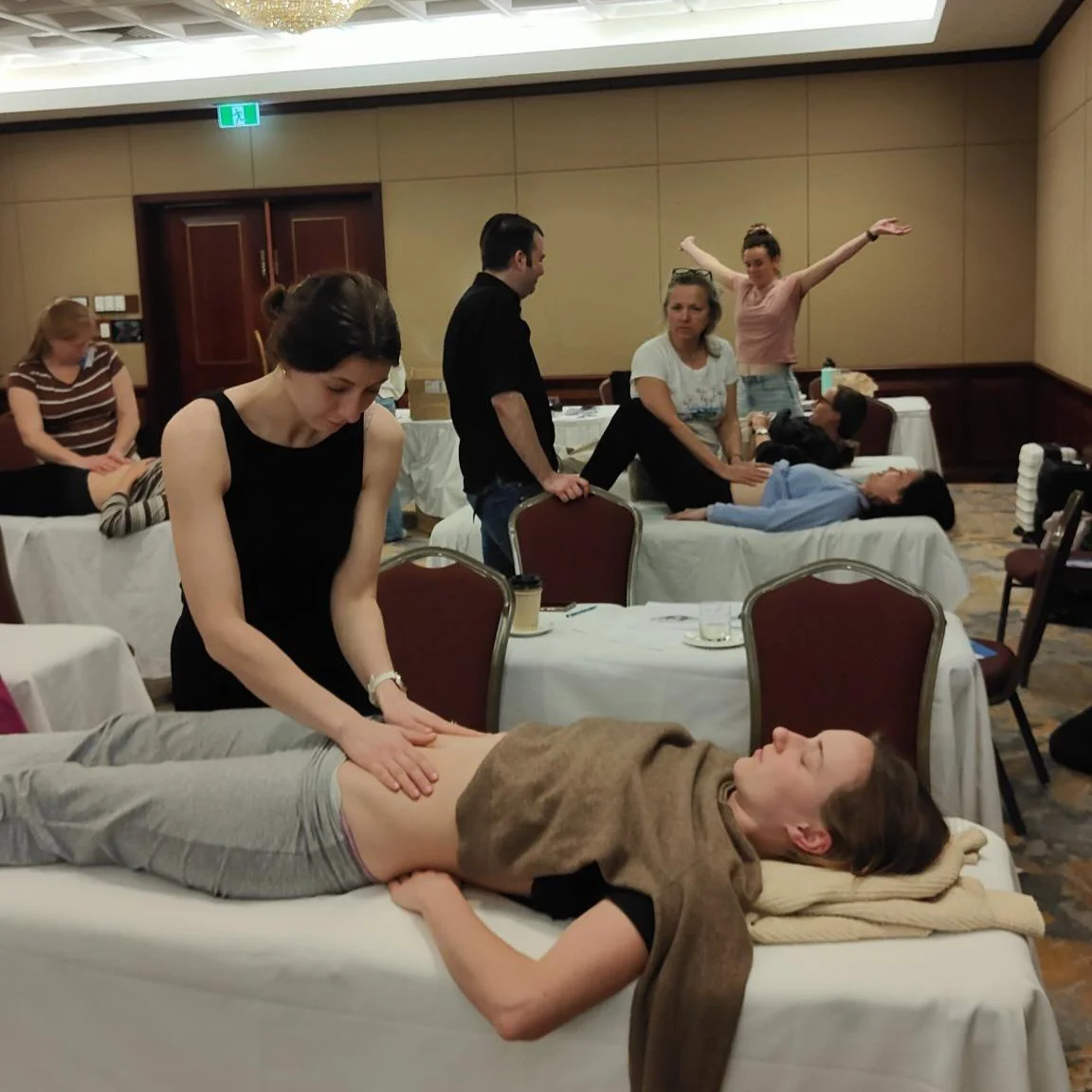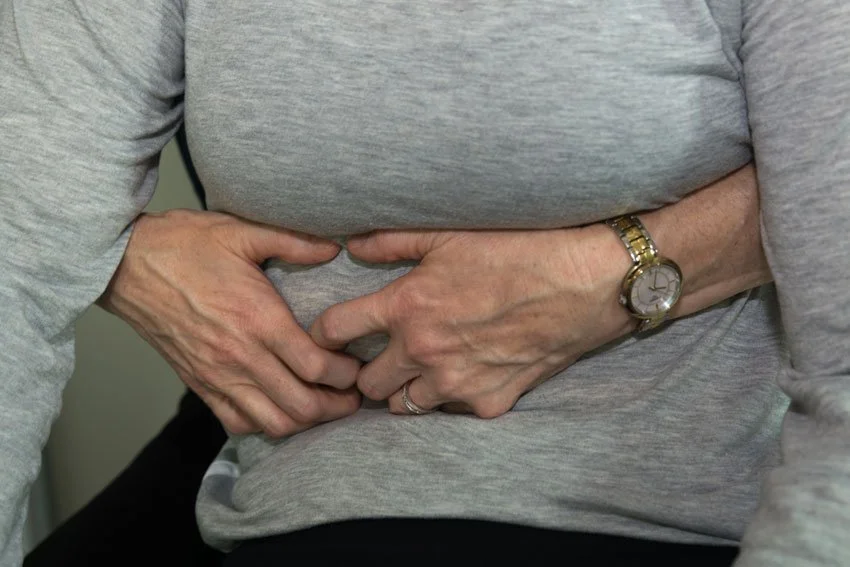What is Visceral Manipulation
Miranda Hart and Daphne Jaffre, two osteopaths I worked with on the VM1 course
I recently had the absolute pleasure of attending Visceral Manipulation 1 with the Barrell Institute in Brisbane
I’ve been wanting to take this course for years and I finally had the opportunity to attend. Let me tell you, it was the single best course of my whole physio career.
I’m sure you’re wondering what visceral manipulation is. My mother thinks it’s me arranging people’s organs inside them to sit in the right spot- she’s absolutely wrong (sorry mum!)
Why Visceral Manipulation?
The theory behind it is that each organ has its own natural rhythm and movement. The kidneys move up to 10cm each time you take a breath! The stomach is only fist sized when empty but can expand to fit up to 4 Liters of food and fluid after a big Christmas feast, and them empty again afterwards.
These rhythms and movement become slow and sluggish, stiff or under stimulated for a whole range of reasons from food intolerances, working hard while helping process medications and infections, illness, trauma from surgeries and injuries etc.
When this happens, the nearby muscles, joints and other tissues can change too in compensation. The organ’s supporting connective tissues don’t have a lot of pain receptors so we don’t always know about the problem in or near the organ until the body can no longer compensate for the problem. It’s then we often begin to feel something is wrong in the body but often interpret this is a musculoskeletal issue as that is where we feel it.
It’s not so crazy to think that the your organs can cause pain in the body when you consider the left sided symptoms a heart attack can be detected by. If you go to a doctor with back pain, they will screen you for kidney issues without you noticing. Anyone who has had a gall bladder attack will be all to aware of the pain in the right side of the back which went along with it. And those of us who menstruate will often feel ovulation as well as menstrual pain.
How Does Visceral Manipulation Work?
Manipulation is a very strong word for something that is an extremely gentle technique. Another term for it is “organ specific fascial mobilisation.”
In reality, the visceral manipulation technique consists of gentle and light pressure, stretches and stimulation to very specific spots in the abdominal area. This might be to the stomach, the liver, the intestines etc.
This may relieve pain for several reasons:
- The brain’s highest priority is keeping you alive and if an organ isn’t feeling or moving as well as it can, the body organises itself around that organ to keep it protected. A lot of “poor posture” may be the body bending forward to provide protection to the abdominal area. What we interpret as a problem with the musculoskeletal area is really an issue with the abdominal organs and the body is doing what it can to deal with it.
- A lot of these organs share sensory nerves with other joints. For example, the liver, the diaphragm, the neck, and the shoulder all send information to the brain with the same nerve- the phrenic nerve. If there is a problem with the liver, the brain may interpret this as a problem with the shoulder and prevent it form moving as normal by getting stiff or even feeling pain.
Sometimes visceral manipulation looks like magic. Apply a gentle pressure to the right area in the abdominal area and the shoulder magically moves and feels better. When this happens, it’s purely through providing the brain and the organs with better sensory information, not by making any physical change to the shape or location of the organ itself.
It’s not a silver bullet for all issues. If food intolerances are causing stress to an organ these intolerances still need to be addressed so the organ can recover properly.
If a shoulder joint is being affected by liver stiffness it may make a great recovery with visceral manipulation but will possibly still need to go through a process of rehabilitating its strength, especially if the problem has been around for a long time.
I was so excited to feel this for myself. After years of gall bladder and skin allergy issues, I was nervous about having my gall bladder treated but fully expected my liver being treated to solve some movement problems. But… it didn’t.
We went on to learn how to treat the intestines and I was fascinated to see that the smallest amount of stimulation helped me fully turn left for the first time in 6 years! And let me tell you, I’ve tried it ALL to get this movement back.
Other Thoughts around Visceral Manipulation
Whilst I’ve loved the experience of learning and feeling visceral manipulation in my own body, I have been left with some questions.
Throughout my physio career, I’ve been continually impressed with how robust and resilient our human bodies are. The things we can recover from! We’re healing machines! I do worry that this message may be tarnished when such gentle techniques make such a profound difference to movement patterns… are we more delicate than I thought?
The more I muse on this, the more I have come to understand that both things are true. We’re amazing at healing, adapting, and compensating. We do what we have to do to get the job done. But every system has a capacity and sometimes we reach the compensatory capacity after multiple insults- injuries, stress, illness can all stack up. We can recover from so much- and then sometimes we need help to continue to recover and adapt.
Another question on my mind is the need for such precision and specificity. Most manual therapy techniques including massages and joint cracking/ manipulation have been proven to be way more general that we ever thought. You don’t need to nail the manipulation on exactly the right joint to have the positive effect on pain and movement that you were expecting.
We’re told this is not at all the way with visceral manipulation where you can apply a fantastic, generalised technique to a variety of organs and it will do a little bit but apply the most basic of techniques to exactly the right spot and you might have amazing outcomes.
It’s these differences in approach that I think are making it hard for the physiotherapy profession to embrace it as quickly as you might expect for such an effective technique. I was in this group too. When I graduated, I had such a strong bias against visceral manipulation considering how little I understood about it. There is now a myriad of research showing its efficacy in helping pain and movement, and yet it is still looked down upon by a lot of my physio peers.
Regardless of the slower uptake by the broader physio community, treating the abdominal organs and surrounding fascia has become an important skill I can no longer ignore if I want the best outcomes for my clients… and myself!
If you’re curious and want to know more, please feel free to email hello@adventurephysio.com.au to ask any questions or click below to book an appointment to experience it yourself.
This article was conceived, researched, and written only by Stephanie Lock, without the use of AI.



